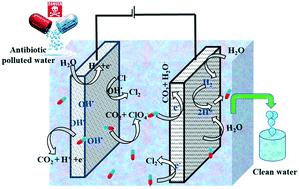当前位置:
X-MOL 学术
›
Environ. Sci.: Nano
›
论文详情
Our official English website, www.x-mol.net, welcomes your feedback! (Note: you will need to create a separate account there.)
Removal of antibiotics from aqueous solutions by electrocatalytic degradation
Environmental Science: Nano ( IF 7.3 ) Pub Date : 2021-3-15 , DOI: 10.1039/d0en01276a Vaishali Choudhary 1, 2, 3, 4, 5 , Kowsalya Vellingiri 1, 2, 3, 4, 5 , Mohammed Iqbal Thayyil 1, 2, 3, 4, 5 , Ligy Philip 1, 2, 3, 4, 5
Environmental Science: Nano ( IF 7.3 ) Pub Date : 2021-3-15 , DOI: 10.1039/d0en01276a Vaishali Choudhary 1, 2, 3, 4, 5 , Kowsalya Vellingiri 1, 2, 3, 4, 5 , Mohammed Iqbal Thayyil 1, 2, 3, 4, 5 , Ligy Philip 1, 2, 3, 4, 5
Affiliation

|
The development of affordable and modular water/wastewater treatment technologies is highly desirable to counter the adverse effects of antibiotics. Electrochemical treatment, especially electrocatalysis, has a vast potential to degrade antibiotics due to its higher treatment efficiency, low power consumption, and flexible design. Correspondingly, the current review broadly discusses the present status and future trends regarding the electrocatalytic degradation of antibiotics. At the beginning, antibiotic distribution and the merits and demerits of conventional treatment technologies are briefly conveyed. Later, the electrocatalytic removal of antibiotics is discussed in detail with a special focus on catalyst type (e.g., metal-based and carbon-based nanomaterials), oxidative/reductive degradation pathways, and reaction mechanisms. A comprehensive assessment of removal efficiency, operational cost, environmental toxicity of nanomaterials, and residual by-product management has also been carried out. Overall, the feasibility of electrocatalysis technology for antibiotic removal and the critical strategies required for its development have been summarized to provide a roadmap for future research.
中文翻译:

通过电催化降解从水溶液中去除抗生素
迫切需要开发负担得起的模块化水/废水处理技术,以应对抗生素的不利影响。电化学处理,尤其是电催化,由于其更高的处理效率,较低的功耗和灵活的设计,具有降解抗生素的巨大潜力。相应地,本综述广泛地讨论了关于抗生素的电催化降解的现状和未来趋势。首先,简要介绍了抗生素的分布以及常规治疗技术的优缺点。稍后,将对抗生素的电催化去除进行详细讨论,重点放在催化剂类型上(例如,金属基和碳基纳米材料),氧化/还原降解途径和反应机理。还对去除效率,运营成本,纳米材料的环境毒性以及残留的副产品管理进行了全面评估。总体而言,总结了电催化技术用于去除抗生素的可行性以及其开发所需的关键策略,为将来的研究提供了路线图。
更新日期:2021-04-15
中文翻译:

通过电催化降解从水溶液中去除抗生素
迫切需要开发负担得起的模块化水/废水处理技术,以应对抗生素的不利影响。电化学处理,尤其是电催化,由于其更高的处理效率,较低的功耗和灵活的设计,具有降解抗生素的巨大潜力。相应地,本综述广泛地讨论了关于抗生素的电催化降解的现状和未来趋势。首先,简要介绍了抗生素的分布以及常规治疗技术的优缺点。稍后,将对抗生素的电催化去除进行详细讨论,重点放在催化剂类型上(例如,金属基和碳基纳米材料),氧化/还原降解途径和反应机理。还对去除效率,运营成本,纳米材料的环境毒性以及残留的副产品管理进行了全面评估。总体而言,总结了电催化技术用于去除抗生素的可行性以及其开发所需的关键策略,为将来的研究提供了路线图。



























 京公网安备 11010802027423号
京公网安备 11010802027423号